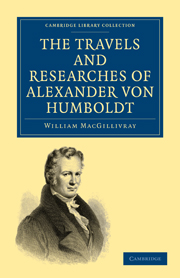 The Travels and Researches of Alexander von Humboldt
The Travels and Researches of Alexander von Humboldt Book contents
- Frontmatter
- PREFACE
- Contents
- CHAPTER I INTRODUCTION
- CHAPTER II VOYAGE FROM CORUNNA TO TENERIFFE
- CHAPTER III ISLAND OF TENERIFFE
- CHAPTER IV PASSAGE FROM TENERIFFE TO CUMANA
- CHAPTER V CUMANA
- CHAPTER VI RESIDENCE AT CUMANA
- CHAPTER VII MISSIONS OF THE CHAYMAS
- CHAPTER VIII EXCURSION CONTINUED, AND RETURN TO CUMANA
- CHAPTER IX INDIANS OF NEW ANDALUSIA
- CHAPTER X RESIDENCE AT CUMANA
- CHAPTER XI VOYAGE FROM CUMANA TO GUAYBA
- CHAPTER XII CITY OF CARACCAS AND SURROUNDING DISTRICT
- CHAPTER XIII EARTHQUAKES OF CARACCAS
- CHAPTER XIV JOURNEY FROM CARACCAS TO THE LAKE OF VALENCIA
- CHAPTER XV JOURNEY ACROSS THE LLANOS, FROM ARAGUA TO SAN FERNANDO
- CHAPTER XVI VOYAGE DOWN THE RIO APURE
- CHAPTER XVII VOYAGE UP THE ORINOCO
- CHAPTER XVIII VOYAGE UP THE ORINOCO CONTINUED
- CHAPTER XIX ROUTE FROM ESMERALDA TO ANGOSTURA
- CHAPTER XX JOURNEY ACROSS THE LLANOS TO NEW BARCELONA
- CHAPTER XXI PASSAGE TO HAVANNAH, AND RESIDENCE IN CUBA
- CHAPTER XXII VOYAGE FROM CUBA TO CARTHAGENA
- CHAPTER XXIII BRIEF ACCOUNT OF THE JOURNEY FROM CARTHAGENA TO QUITO AND MEXICO
- CHAPTER XXIV DESCRIPTION OF NEW SPAIN OR MEXICO
- CHAPTER XXV STATISTICAL ACCOUNT OF NEW SPAIN CONTINUED
- CHAPTER XXVI MINES OF NEW SPAIN
- CHAPTER XXVII PASSAGE FROM VERA CRUZ TO CUBA AND PHILADELPHIA, AND VOYAGE TO EUROPE
- CHAPTER XXVIII JOURNEY TO ASIA
CHAPTER XXV - STATISTICAL ACCOUNT OF NEW SPAIN CONTINUED
Published online by Cambridge University Press: 29 August 2010
- Frontmatter
- PREFACE
- Contents
- CHAPTER I INTRODUCTION
- CHAPTER II VOYAGE FROM CORUNNA TO TENERIFFE
- CHAPTER III ISLAND OF TENERIFFE
- CHAPTER IV PASSAGE FROM TENERIFFE TO CUMANA
- CHAPTER V CUMANA
- CHAPTER VI RESIDENCE AT CUMANA
- CHAPTER VII MISSIONS OF THE CHAYMAS
- CHAPTER VIII EXCURSION CONTINUED, AND RETURN TO CUMANA
- CHAPTER IX INDIANS OF NEW ANDALUSIA
- CHAPTER X RESIDENCE AT CUMANA
- CHAPTER XI VOYAGE FROM CUMANA TO GUAYBA
- CHAPTER XII CITY OF CARACCAS AND SURROUNDING DISTRICT
- CHAPTER XIII EARTHQUAKES OF CARACCAS
- CHAPTER XIV JOURNEY FROM CARACCAS TO THE LAKE OF VALENCIA
- CHAPTER XV JOURNEY ACROSS THE LLANOS, FROM ARAGUA TO SAN FERNANDO
- CHAPTER XVI VOYAGE DOWN THE RIO APURE
- CHAPTER XVII VOYAGE UP THE ORINOCO
- CHAPTER XVIII VOYAGE UP THE ORINOCO CONTINUED
- CHAPTER XIX ROUTE FROM ESMERALDA TO ANGOSTURA
- CHAPTER XX JOURNEY ACROSS THE LLANOS TO NEW BARCELONA
- CHAPTER XXI PASSAGE TO HAVANNAH, AND RESIDENCE IN CUBA
- CHAPTER XXII VOYAGE FROM CUBA TO CARTHAGENA
- CHAPTER XXIII BRIEF ACCOUNT OF THE JOURNEY FROM CARTHAGENA TO QUITO AND MEXICO
- CHAPTER XXIV DESCRIPTION OF NEW SPAIN OR MEXICO
- CHAPTER XXV STATISTICAL ACCOUNT OF NEW SPAIN CONTINUED
- CHAPTER XXVI MINES OF NEW SPAIN
- CHAPTER XXVII PASSAGE FROM VERA CRUZ TO CUBA AND PHILADELPHIA, AND VOYAGE TO EUROPE
- CHAPTER XXVIII JOURNEY TO ASIA
Summary
A country extending from the sixteenth to the thirty-seventh degree of latitude, and presenting a great variety of surface, necessarily affords numerous modifications of climate. Such is the admirable distribution of heat on the globe, that the strata of the atmosphere become colder as we ascend, while those of the sea are warmest near the surface. Hence, under the tropics, on the declivities of the Cordilleras, and in the depths of the ocean, the plants and marine animals of the polar regions find a temperature suited to their development. It may easily be conceived that, in a mountainous country like Mexico, having so great a diversity of elevation, temperature, and soil, the variety of indigenous productions must be immense; and that most of the plants cultivated in other parts of the globe may there find situations adapted to their nature.
There, however, the principal objects of agriculture are not the productions which European luxury draws from the West India Islands, but the grasses, nutritive roots, and the agave. The appearance of the land proclaims to the traveller that the natives are nourished by the soil, and that they are independent of foreign commerce. Yet agriculture is by no means so flourishing as might be expected from its natural resources, although considerable improvement has been effected of late years. The depressed state of cultivation, it is true, has been attributed to the existence of numerous rich mines; but Humboldt, on the contrary, maintains that the working of these ores has been beneficial in causing many places to be improved which would otherwise have remained steril.
- Type
- Chapter
- Information
- The Travels and Researches of Alexander von HumboldtBeing a Condensed Narrative of his Journeys in the Equinoctial Regions of America, and in Asiatic Russia; Together with Analyses of his More Important Investigations, pp. 375 - 389Publisher: Cambridge University PressPrint publication year: 2009First published in: 1832


